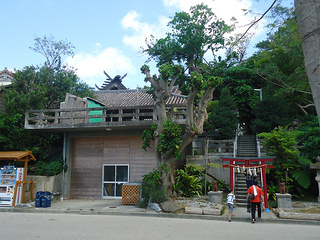Oki Shrine
- Japanese: 沖宮 (Oki-guu)
Oki Shrine is a Shinto shrine in Naha, and is counted among the Eight Shrines of Ryûkyû.
Though originally located within the grounds of the Buddhist temple Rinkai-ji, on a spit of land sticking out into Naha Harbor, in order to develop the harbor, the shrine was moved in 1908 onto the grounds of Asato Hachimangû; it was designated a National Treasure in 1935, but was destroyed in the 1945 Battle of Okinawa. The shrine was then re-established in 1961, and moved to its current location in Onoyama Park in 1975.
The shrine is dedicated to Kumano Gongen, and was a prominent site for prayers for safe journeys. It is mentioned in the classical song Nubui kuduchi, a travel song about the journey to Kagoshima.
Constructed on a hillside, the shrine combines typical Japanese Shintô architectural elements, such as the torii gates and criss-crossing roofbeams, with traditional Okinawan elements, including red earthenware roof tiles. Upper sections of the grounds also include several small utaki (sacred spaces of the native Ryukyuan religion), and a monument or shrine erected in 2003 and dedicated to Okinawa as an "island of world peace."
References
- Plaques on-site.
- "Oki-gû," Okinawa Compact Encyclopedia 沖縄コンパクト事典, Ryukyu Shimpo, 1 March 2003.
